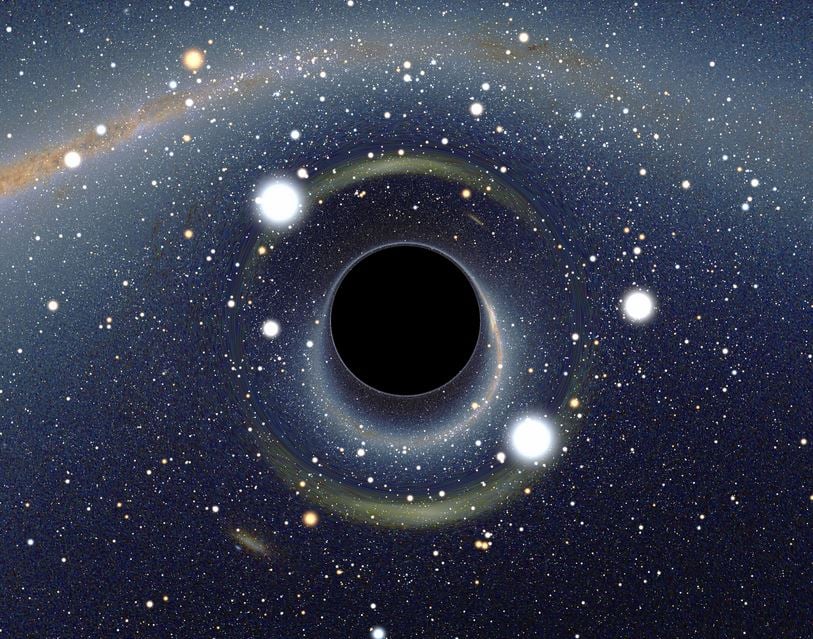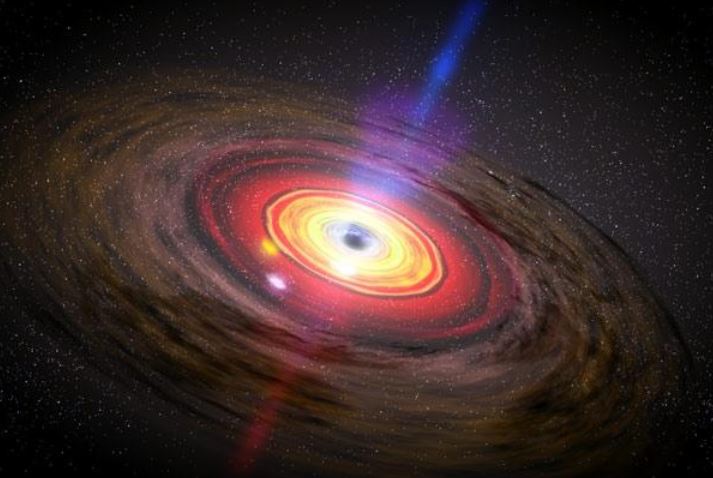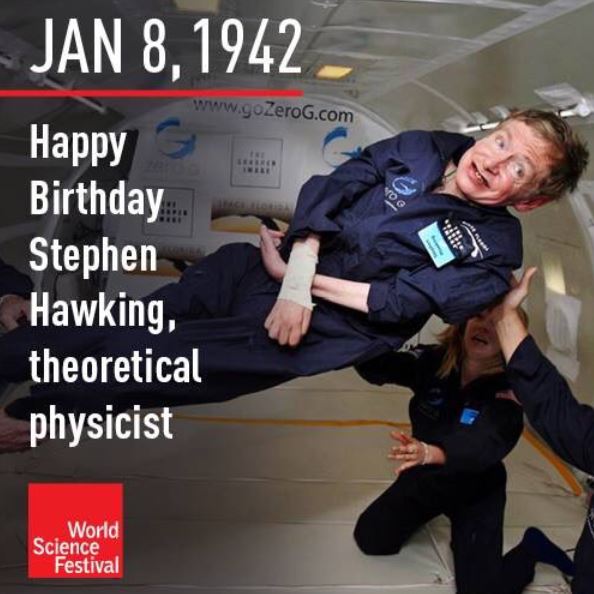Professor Stephen Hawking, the famous, charismatic theoretical physicist, who put forward the hypothesis that black holes may emit a type of radiation – Hawking Radiation – can be heard on BBC Radio 4 tomorrow from 9 to 9.30 am, delivering the second of his Reith Lectures on black holes.
The BBC Reith Lectures are given once annually by leading figures of the day. Tomorrow’s programme will be hosted by Sue Lawley.
Prof. Hawking challenges the idea that all matter and data are destroyed within the enigmatic interior of black holes.
 Prof. Hawking examines scientific thinking regarding black holes and challenges the idea that all matter and information is destroyed irretrievably within them. (Image: BBC Radio 4)
Prof. Hawking examines scientific thinking regarding black holes and challenges the idea that all matter and information is destroyed irretrievably within them. (Image: BBC Radio 4)
Recorded at the Royal Institution of Great Britain in London, in front of a captivated audience of Radio 4 listeners and eminent scientists, Prof. Hawking jokes that “no one has found any black holes, which is a pity because if they had, I’d have got a Nobel Prize.”
What are black holes?
Black holes are mysterious places that exist in galaxies and behave like a bit like mega-powerful vacuum cleaners – they suck in anything that comes within their incredibly powerful gravitational pull.
Put simply, black holes are places with such unimaginably intense gravity that nothing can get away if it gets too close. They are different to all other celestial objects, where one could – in theory – build a rocket powerful enough to escape from their pull.
With a black hole, however, you would need a virtually infinite amount of energy to get away once it digs its claws into you.
Nobody’s ever seen a black hole
We know they exist, physicists say – the laws of physics predict their existence. However, what happens inside them is a pitch-black mystery. Scientists have theories, but really, nobody knows.
 John Michell (1724-1793), an English clegyman and natural philosopher, was the first person to mention that there might be such things as black holes. He called them ‘dark stars’ when he presented a paper for the Philosophical Transactions of the Royal Society of London, on 27th November, 1783. (Image: Wikipedia)
John Michell (1724-1793), an English clegyman and natural philosopher, was the first person to mention that there might be such things as black holes. He called them ‘dark stars’ when he presented a paper for the Philosophical Transactions of the Royal Society of London, on 27th November, 1783. (Image: Wikipedia)
As soon as we find a black hole and can look inside it, we will have taken a giant step beyond Albert Einstein’s work, and we’ll have a far deeper understanding of the Universe.
The point of no return, in the world of black holes, is called the Event Horizon. It is an invisible threshold, beyond which trying to resist is futile.
In Albert Einstein’s General Theory of Relativity, published 101 years ago, he stated that the strength of a celestial object’s gravitational field is determined by how dense the matter within it is: the higher the density the more powerful its gravity is.
That’s all well and good, but where does that process stop? In a black hole, nothing known to us can resist its overpowering gravity. Many scientists tell us that when matter enters a black hole it is crushed out of existence, i.e. squashed into nothing!
 Many cultural myths concerning black holes exist, some of them are perpetuated by television and movies. They have been portrayed as time-traveling tunnels to another dimension, or as cosmic vacuum cleaners sucking up everything in sight. NASA says “black holes are really just the evolutionary end points of massive stars. Somehow, this simple explanation makes them no easier to understand.” (Image: nasa.gov)
Many cultural myths concerning black holes exist, some of them are perpetuated by television and movies. They have been portrayed as time-traveling tunnels to another dimension, or as cosmic vacuum cleaners sucking up everything in sight. NASA says “black holes are really just the evolutionary end points of massive stars. Somehow, this simple explanation makes them no easier to understand.” (Image: nasa.gov)
How is infinitely dense with no volume possible?
It is a frightening way to describe a mathematical object known as a singularity – infinitely dense with no volume. Sounds impossible, doesn’t it? Many physicists think so too, and wonder whether such objects could really exist.
Quantum gravity theories, which approach this problem by looking at gravity in the smallest scales possible, try to explain what is going on, as does string theory. However, none of them is strong enough to be deemed compelling.
Writing in the Guardian today, Stuart Clark, author of The Unknown Universe (Head of Zeus), and co-host of the podcast The Stuniverse, he says that a compelling (successful) quantum gravity theory would allow scientists to do two things:
1. Look inside a black hole.
2. Learn a great deal about the Big Bang – the origin of the Universe. The Big Bang is another place in nature where relativity predicts a singularity could appear.
 Prof. Hawking joked that if somebody actually managed to see a black hole, he’d be awarded the Nobel Prize for Physics. (Image: hawking.org.uk)
Prof. Hawking joked that if somebody actually managed to see a black hole, he’d be awarded the Nobel Prize for Physics. (Image: hawking.org.uk)
Prof. Hawking closer to Nobel Prize?
Prof. Hawking is 74 years old, he has won virtually every prize under the Sun, he has been given the keys to goodness knows how many cities and centres of excellence, and is a fellow of a string of prestigious institutions, but the biggest prize of all – the Nobel Prize for Physics – has so far eluded him.
There is growing talk in the scientific community and media that he is closer to becoming a Nobel Laureate (Nobel Prize winner), as evidence is emerging that may prove his work into radiation from black holes.
According to the ‘Hawking Radiation’ theory, black holes emit radiation. If this is the case, smaller black holes would evaporate. If this can be proved, he’ll be on the next plane to Stockholm to receive the ultimate prize.
During the Reith Lecture, as he talked about his theory and the evidence he is trying to get, Prof. Hawking displayed a picture of the prizewinner’s medal. Why? Does he know something we don’t?
 Prof. Hawking once said “However difficult life may seem, there is always something you can do and succeed at.” (Image: twitter.com/_Four_Horsemen)
Prof. Hawking once said “However difficult life may seem, there is always something you can do and succeed at.” (Image: twitter.com/_Four_Horsemen)
Hawking Radiation
According to Prof. Hawking, black holes are not really entirely black. They emit radiation due to the quantum effect near the Event Horizon. Consequently, they lose mass and eventually disappear completely.
He predicted that energy variations from the vacuum cause the generation of pairs of particle-antiparticles of virtual particles near the event horizon. One of the particles falls back into the black hole while the other one escapes – this occurs before they get the chance to annihilate each other.
The escaping particle has positive energy, while the one that gets absorbed by the black hole has negative energy (relative to the outside Universe). Consequently, the black hole loses energy, and therefore mass (because E = mc2).
He made this discovery in the 1970s and proudly announced it. The problem is nobody has been able to verify (prove) his predictions.
Before he presented his hypothesis, scientists were convinced that black holes could not get smaller because they were sucking stuff in all the time and nothing was getting away.
The Large Hadron Collider (LHC) at CERN in Switzerland has been revamped – it was a mighty beast before, now it is a mega-beast. Its scientists are exploring new horizons with a much more powerful 14 GeV working energy level.
Researchers at CERN are hopeful that they will find tiny black holes in the remains of smashed particles. If they manage to do this, they will be able to study them and maybe prove Hawking’s theory.
Video – Stephen Hawking mini bio
This short biography talks about Prof. Hawking’s childhood, his theory on black holes, his living with lou gehrig disease (ALS), and his popular science book ‘A Brief History of Time’.
